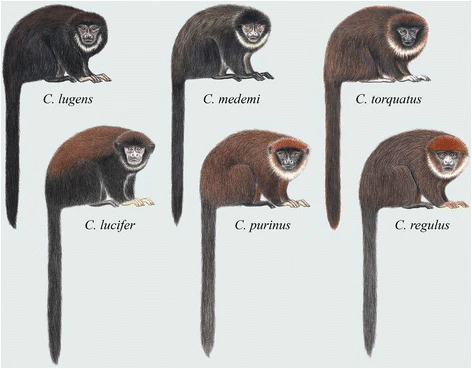Cheracebus on:
[Wikipedia]
[Google]
[Amazon]
''Cheracebus'' is one of three

genera
Genus (; : genera ) is a taxonomic rank above species and below family as used in the biological classification of living and fossil organisms as well as viruses. In binomial nomenclature, the genus name forms the first part of the binomial s ...
of titi monkey
The titis, or titi monkeys, are New World monkeys of the subfamily Callicebinae, which contains three extant genera: ''Cheracebus'', ''Callicebus'', and ''Plecturocebus.'' This subfamily also contains the extinct genera '' Miocallicebus, Homun ...
s. Monkeys in this genus, particularly the type species
In International_Code_of_Zoological_Nomenclature, zoological nomenclature, a type species (''species typica'') is the species name with which the name of a genus or subgenus is considered to be permanently taxonomically associated, i.e., the spe ...
''Cheracebus lugens
The black titi monkey (''Cheracebus lugens''), is a species of titi, a type of New World monkey, from South America. It is found in Brazil, Colombia, and Venezuela. It was described in 1811 as ''Callicebus lugens''. It is sometimes called the ...
'', are sometimes referred to as widow titi monkeys.
Historically, titis were monogeneric, comprising only the genus ''Callicebus'' Thomas, 1903. Owing to the great diversity found across titi monkey species, a new genus-level taxonomy was recently proposed that recognises three genera within the subfamily Callicebinae
The titis, or titi monkeys, are New World monkeys of the subfamily Callicebinae, which contains three extant genera: ''Cheracebus'', ''Callicebus'', and ''Plecturocebus.'' This subfamily also contains the extinct genera '' Miocallicebus, Homun ...
; ''Cheracebus'' Byrne et al., 2016 for the species of the ''torquatus'' group (Widow titis); ''Plecturocebus
''Plecturocebus'' is one of three genera of titi monkeys.
Historically, these monkeys were monotypic taxon, monogeneric, being placed in a single genus: ''Callicebus'' Thomas, 1903. Owing to the great diversity found across titi monkey species, ...
'' Byrne et al., 2016 for the Amazonian and Chaco titis of the ''moloch'' and ''donacophilus'' groups; and ''Callicebus
''Callicebus'' is a genus of monkeys known as titi monkeys.
Historically, titis were monogeneric, comprising only the genus ''Callicebus'' Thomas, 1903. Owing to the great diversity found across titi monkey species, a new genus-level taxonomy wa ...
'' Thomas, 1903 ''sensu stricto'', for species of the Atlantic Forest ''personatus'' group.
''Cheracebus'' is derived from the Latin ''chera'' (from the Greek ) meaning widow and ''cebus'' (from the Greek ) meaning long tailed monkey.
Species
There are 5 species in this genus: *Lucifer titi monkey
The Lucifer titi monkey (''Cheracebus lucifer'') is a species of titi, a type of New World monkey, from South America. It is found in Brazil, Colombia, Ecuador, and Peru
Peru, officially the Republic of Peru, is a country in western Sout ...
, ''Cheracebus lucifer''
* Black titi monkey
The black titi monkey (''Cheracebus lugens''), is a species of titi, a type of New World monkey, from South America. It is found in Brazil, Colombia, and Venezuela. It was described in 1811 as ''Callicebus lugens''. It is sometimes called the ...
, ''Cheracebus lugens''
* Colombian black-handed titi monkey, ''Cheracebus medemi''
* Red-headed titi monkey, ''Cheracebus regulus''
* Collared titi monkey
The collared titi monkey (''Cheracebus torquatus'') is a species of titi, a type of New World monkey. It is endemic to northern Brazil.
Taxonomy
At the end of the 1980s, the genus '' Callicebus'' was revised from the Hershkovitz concept of t ...
, ''Cheracebus torquatus''

References
{{Taxonbar, from=Q25386202 Primate genera Taxa described in 2016 Taxa named by Maria Nazareth Ferreira da Silva Taxa named by Colin Groves Taxa named by Russell Mittermeier